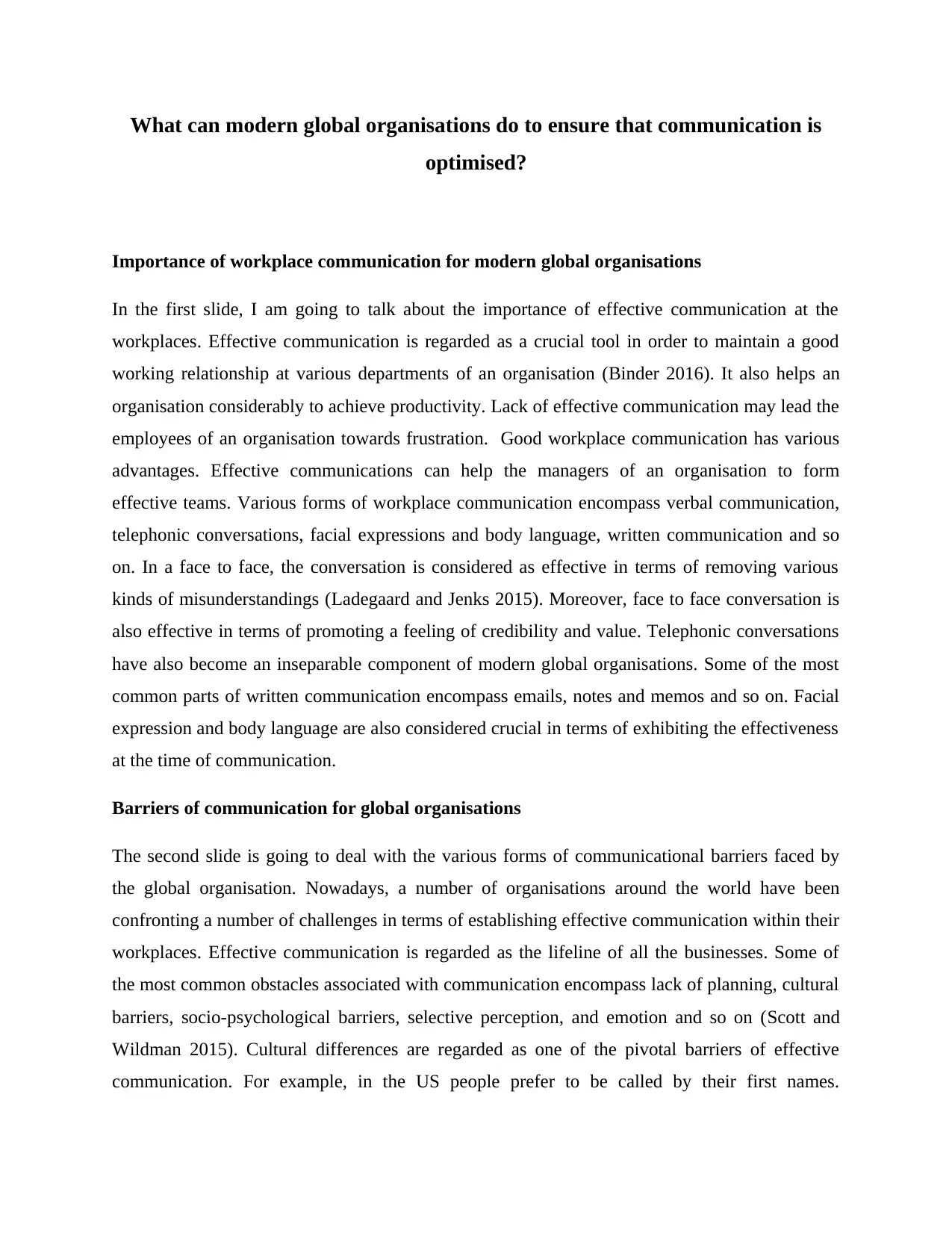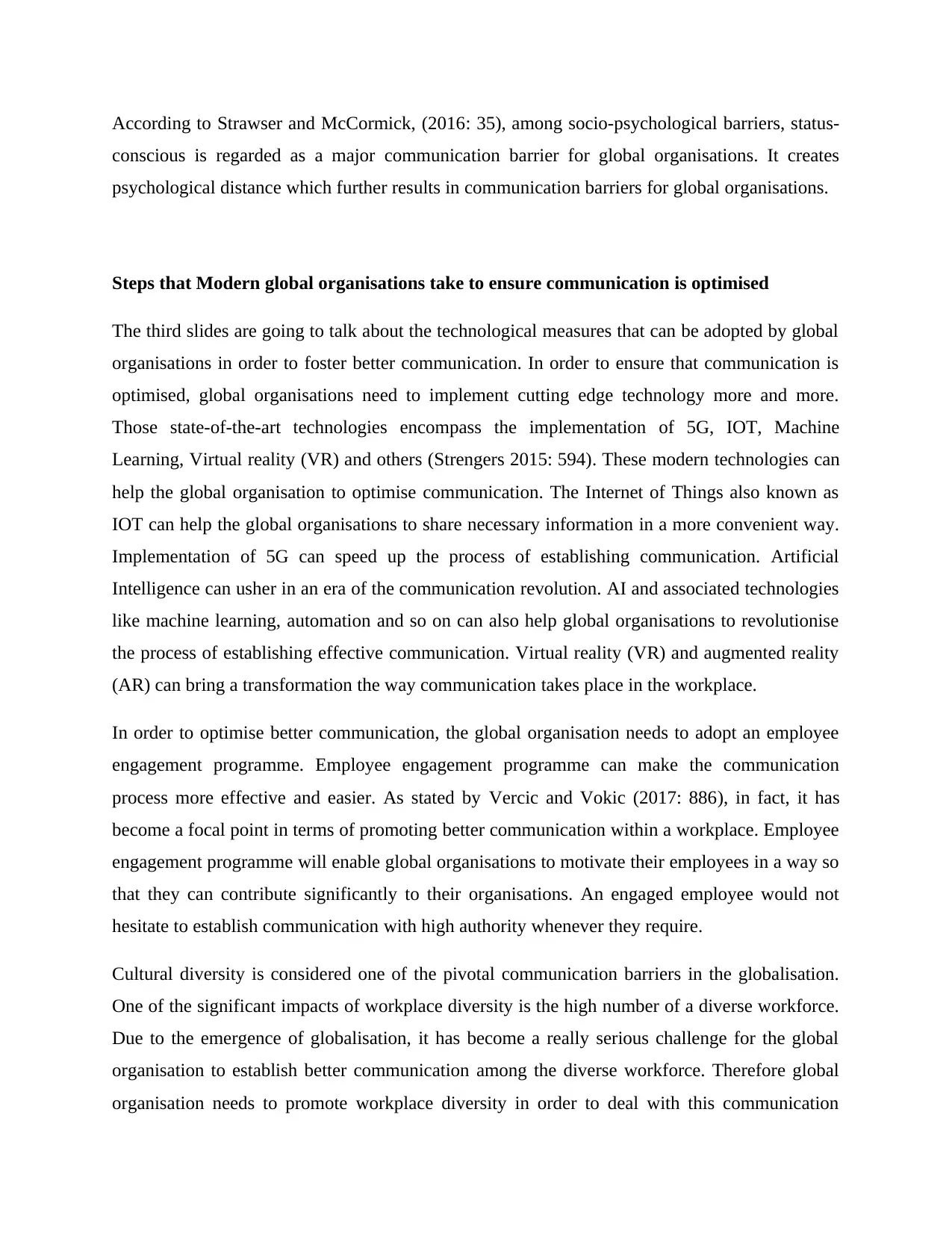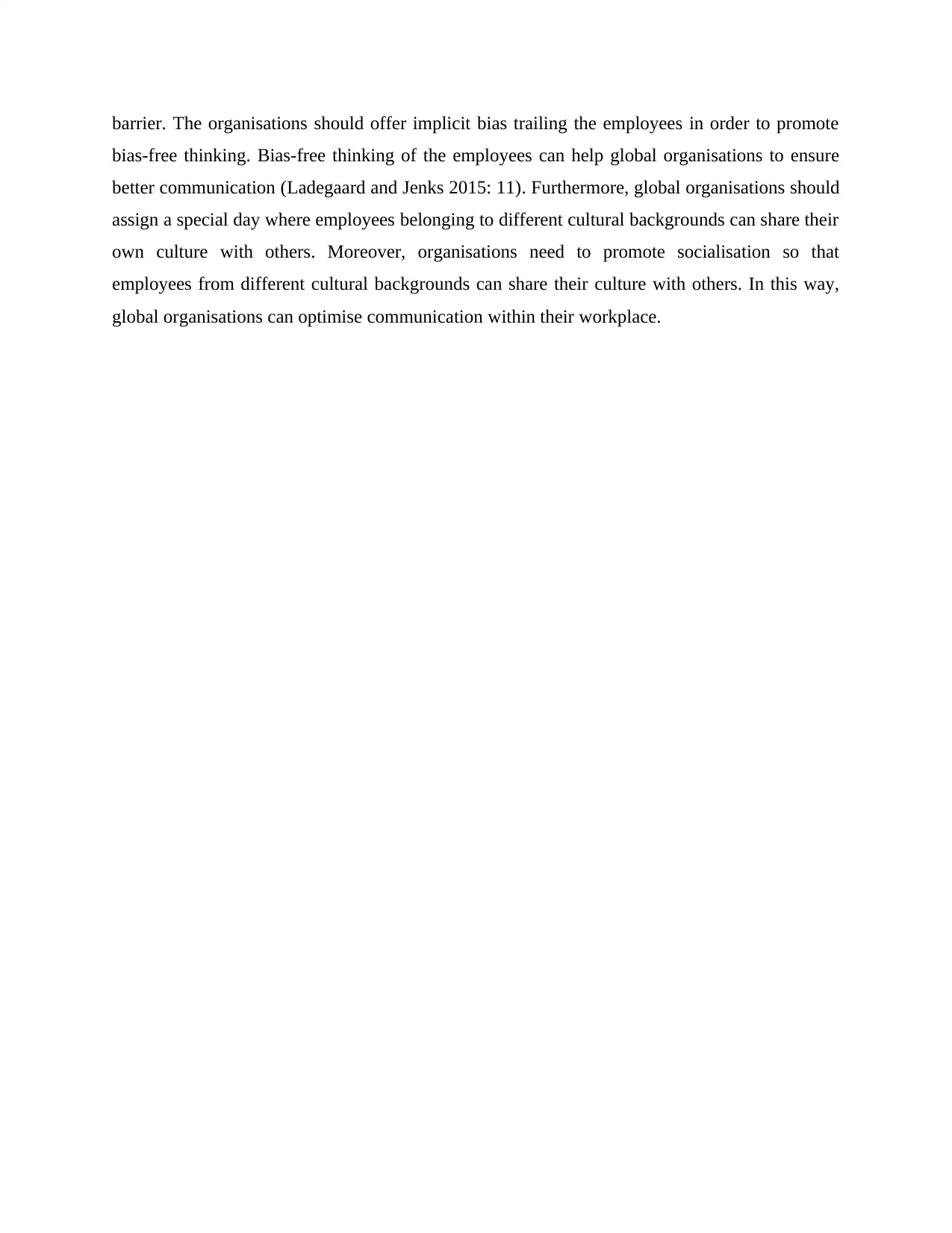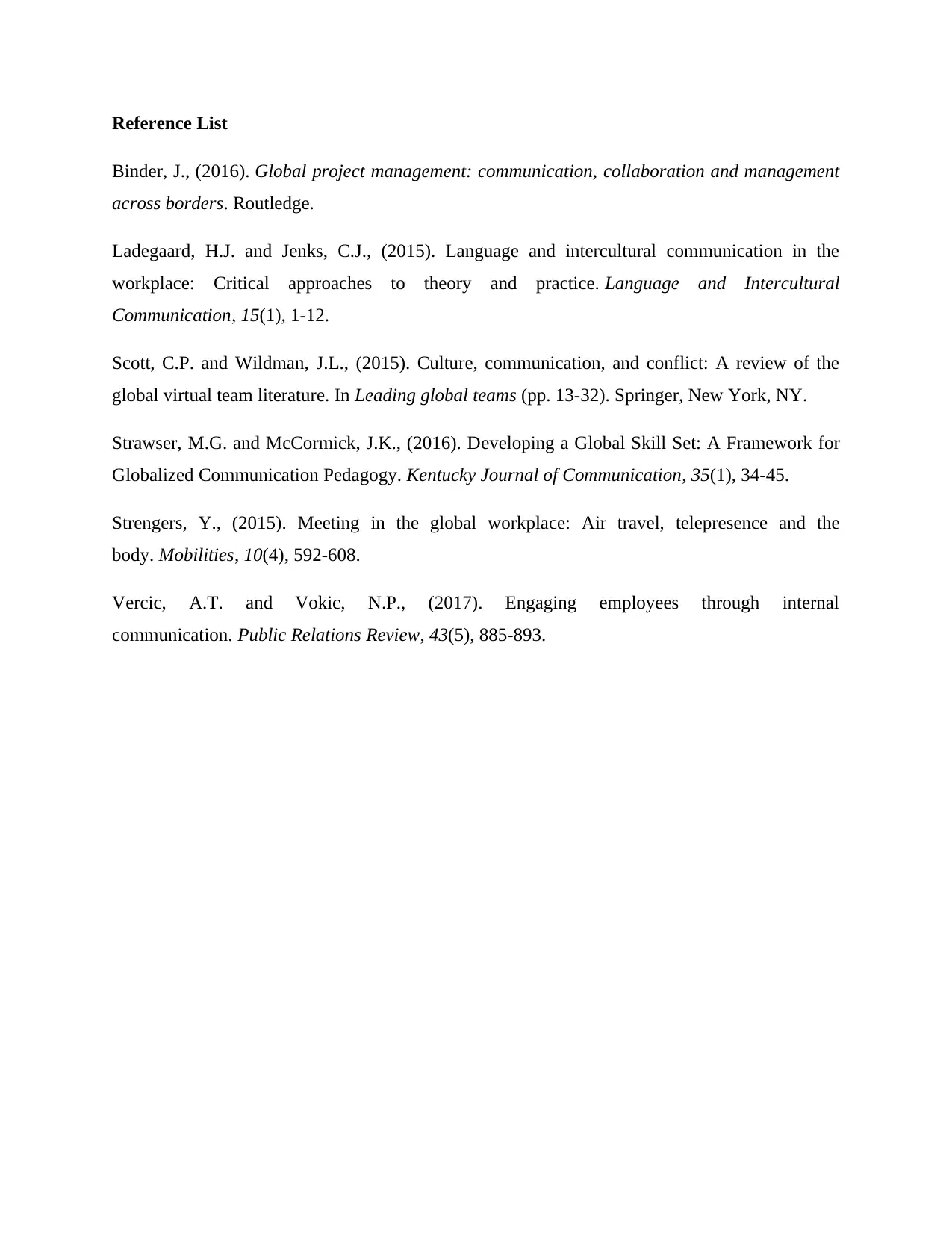111SAM: Communication Optimisation in Modern Global Organisations
VerifiedAdded on 2023/01/18
|4
|1083
|90
Presentation
AI Summary
This presentation discusses how modern global organizations can optimize communication by addressing its importance and barriers. It highlights the significance of effective workplace communication for maintaining good working relationships, achieving productivity, and preventing employee frustration. The presentation identifies common communication barriers such as lack of planning, cultural differences, socio-psychological factors, and selective perception. Furthermore, it proposes solutions including the adoption of cutting-edge technologies like 5G, IoT, machine learning, and virtual reality to enhance communication processes. Additionally, the presentation emphasizes the importance of employee engagement programs and promoting workplace diversity through bias training and cultural exchange to foster better communication within global organizations. The presentation references academic sources to support its claims and recommendations.

What can modern global organisations do to ensure that communication is
optimised?
Importance of workplace communication for modern global organisations
In the first slide, I am going to talk about the importance of effective communication at the
workplaces. Effective communication is regarded as a crucial tool in order to maintain a good
working relationship at various departments of an organisation (Binder 2016). It also helps an
organisation considerably to achieve productivity. Lack of effective communication may lead the
employees of an organisation towards frustration. Good workplace communication has various
advantages. Effective communications can help the managers of an organisation to form
effective teams. Various forms of workplace communication encompass verbal communication,
telephonic conversations, facial expressions and body language, written communication and so
on. In a face to face, the conversation is considered as effective in terms of removing various
kinds of misunderstandings (Ladegaard and Jenks 2015). Moreover, face to face conversation is
also effective in terms of promoting a feeling of credibility and value. Telephonic conversations
have also become an inseparable component of modern global organisations. Some of the most
common parts of written communication encompass emails, notes and memos and so on. Facial
expression and body language are also considered crucial in terms of exhibiting the effectiveness
at the time of communication.
Barriers of communication for global organisations
The second slide is going to deal with the various forms of communicational barriers faced by
the global organisation. Nowadays, a number of organisations around the world have been
confronting a number of challenges in terms of establishing effective communication within their
workplaces. Effective communication is regarded as the lifeline of all the businesses. Some of
the most common obstacles associated with communication encompass lack of planning, cultural
barriers, socio-psychological barriers, selective perception, and emotion and so on (Scott and
Wildman 2015). Cultural differences are regarded as one of the pivotal barriers of effective
communication. For example, in the US people prefer to be called by their first names.
optimised?
Importance of workplace communication for modern global organisations
In the first slide, I am going to talk about the importance of effective communication at the
workplaces. Effective communication is regarded as a crucial tool in order to maintain a good
working relationship at various departments of an organisation (Binder 2016). It also helps an
organisation considerably to achieve productivity. Lack of effective communication may lead the
employees of an organisation towards frustration. Good workplace communication has various
advantages. Effective communications can help the managers of an organisation to form
effective teams. Various forms of workplace communication encompass verbal communication,
telephonic conversations, facial expressions and body language, written communication and so
on. In a face to face, the conversation is considered as effective in terms of removing various
kinds of misunderstandings (Ladegaard and Jenks 2015). Moreover, face to face conversation is
also effective in terms of promoting a feeling of credibility and value. Telephonic conversations
have also become an inseparable component of modern global organisations. Some of the most
common parts of written communication encompass emails, notes and memos and so on. Facial
expression and body language are also considered crucial in terms of exhibiting the effectiveness
at the time of communication.
Barriers of communication for global organisations
The second slide is going to deal with the various forms of communicational barriers faced by
the global organisation. Nowadays, a number of organisations around the world have been
confronting a number of challenges in terms of establishing effective communication within their
workplaces. Effective communication is regarded as the lifeline of all the businesses. Some of
the most common obstacles associated with communication encompass lack of planning, cultural
barriers, socio-psychological barriers, selective perception, and emotion and so on (Scott and
Wildman 2015). Cultural differences are regarded as one of the pivotal barriers of effective
communication. For example, in the US people prefer to be called by their first names.
Paraphrase This Document
Need a fresh take? Get an instant paraphrase of this document with our AI Paraphraser

According to Strawser and McCormick, (2016: 35), among socio-psychological barriers, status-
conscious is regarded as a major communication barrier for global organisations. It creates
psychological distance which further results in communication barriers for global organisations.
Steps that Modern global organisations take to ensure communication is optimised
The third slides are going to talk about the technological measures that can be adopted by global
organisations in order to foster better communication. In order to ensure that communication is
optimised, global organisations need to implement cutting edge technology more and more.
Those state-of-the-art technologies encompass the implementation of 5G, IOT, Machine
Learning, Virtual reality (VR) and others (Strengers 2015: 594). These modern technologies can
help the global organisation to optimise communication. The Internet of Things also known as
IOT can help the global organisations to share necessary information in a more convenient way.
Implementation of 5G can speed up the process of establishing communication. Artificial
Intelligence can usher in an era of the communication revolution. AI and associated technologies
like machine learning, automation and so on can also help global organisations to revolutionise
the process of establishing effective communication. Virtual reality (VR) and augmented reality
(AR) can bring a transformation the way communication takes place in the workplace.
In order to optimise better communication, the global organisation needs to adopt an employee
engagement programme. Employee engagement programme can make the communication
process more effective and easier. As stated by Vercic and Vokic (2017: 886), in fact, it has
become a focal point in terms of promoting better communication within a workplace. Employee
engagement programme will enable global organisations to motivate their employees in a way so
that they can contribute significantly to their organisations. An engaged employee would not
hesitate to establish communication with high authority whenever they require.
Cultural diversity is considered one of the pivotal communication barriers in the globalisation.
One of the significant impacts of workplace diversity is the high number of a diverse workforce.
Due to the emergence of globalisation, it has become a really serious challenge for the global
organisation to establish better communication among the diverse workforce. Therefore global
organisation needs to promote workplace diversity in order to deal with this communication
conscious is regarded as a major communication barrier for global organisations. It creates
psychological distance which further results in communication barriers for global organisations.
Steps that Modern global organisations take to ensure communication is optimised
The third slides are going to talk about the technological measures that can be adopted by global
organisations in order to foster better communication. In order to ensure that communication is
optimised, global organisations need to implement cutting edge technology more and more.
Those state-of-the-art technologies encompass the implementation of 5G, IOT, Machine
Learning, Virtual reality (VR) and others (Strengers 2015: 594). These modern technologies can
help the global organisation to optimise communication. The Internet of Things also known as
IOT can help the global organisations to share necessary information in a more convenient way.
Implementation of 5G can speed up the process of establishing communication. Artificial
Intelligence can usher in an era of the communication revolution. AI and associated technologies
like machine learning, automation and so on can also help global organisations to revolutionise
the process of establishing effective communication. Virtual reality (VR) and augmented reality
(AR) can bring a transformation the way communication takes place in the workplace.
In order to optimise better communication, the global organisation needs to adopt an employee
engagement programme. Employee engagement programme can make the communication
process more effective and easier. As stated by Vercic and Vokic (2017: 886), in fact, it has
become a focal point in terms of promoting better communication within a workplace. Employee
engagement programme will enable global organisations to motivate their employees in a way so
that they can contribute significantly to their organisations. An engaged employee would not
hesitate to establish communication with high authority whenever they require.
Cultural diversity is considered one of the pivotal communication barriers in the globalisation.
One of the significant impacts of workplace diversity is the high number of a diverse workforce.
Due to the emergence of globalisation, it has become a really serious challenge for the global
organisation to establish better communication among the diverse workforce. Therefore global
organisation needs to promote workplace diversity in order to deal with this communication

barrier. The organisations should offer implicit bias trailing the employees in order to promote
bias-free thinking. Bias-free thinking of the employees can help global organisations to ensure
better communication (Ladegaard and Jenks 2015: 11). Furthermore, global organisations should
assign a special day where employees belonging to different cultural backgrounds can share their
own culture with others. Moreover, organisations need to promote socialisation so that
employees from different cultural backgrounds can share their culture with others. In this way,
global organisations can optimise communication within their workplace.
bias-free thinking. Bias-free thinking of the employees can help global organisations to ensure
better communication (Ladegaard and Jenks 2015: 11). Furthermore, global organisations should
assign a special day where employees belonging to different cultural backgrounds can share their
own culture with others. Moreover, organisations need to promote socialisation so that
employees from different cultural backgrounds can share their culture with others. In this way,
global organisations can optimise communication within their workplace.
⊘ This is a preview!⊘
Do you want full access?
Subscribe today to unlock all pages.

Trusted by 1+ million students worldwide

Reference List
Binder, J., (2016). Global project management: communication, collaboration and management
across borders. Routledge.
Ladegaard, H.J. and Jenks, C.J., (2015). Language and intercultural communication in the
workplace: Critical approaches to theory and practice. Language and Intercultural
Communication, 15(1), 1-12.
Scott, C.P. and Wildman, J.L., (2015). Culture, communication, and conflict: A review of the
global virtual team literature. In Leading global teams (pp. 13-32). Springer, New York, NY.
Strawser, M.G. and McCormick, J.K., (2016). Developing a Global Skill Set: A Framework for
Globalized Communication Pedagogy. Kentucky Journal of Communication, 35(1), 34-45.
Strengers, Y., (2015). Meeting in the global workplace: Air travel, telepresence and the
body. Mobilities, 10(4), 592-608.
Vercic, A.T. and Vokic, N.P., (2017). Engaging employees through internal
communication. Public Relations Review, 43(5), 885-893.
Binder, J., (2016). Global project management: communication, collaboration and management
across borders. Routledge.
Ladegaard, H.J. and Jenks, C.J., (2015). Language and intercultural communication in the
workplace: Critical approaches to theory and practice. Language and Intercultural
Communication, 15(1), 1-12.
Scott, C.P. and Wildman, J.L., (2015). Culture, communication, and conflict: A review of the
global virtual team literature. In Leading global teams (pp. 13-32). Springer, New York, NY.
Strawser, M.G. and McCormick, J.K., (2016). Developing a Global Skill Set: A Framework for
Globalized Communication Pedagogy. Kentucky Journal of Communication, 35(1), 34-45.
Strengers, Y., (2015). Meeting in the global workplace: Air travel, telepresence and the
body. Mobilities, 10(4), 592-608.
Vercic, A.T. and Vokic, N.P., (2017). Engaging employees through internal
communication. Public Relations Review, 43(5), 885-893.
1 out of 4
Related Documents
Your All-in-One AI-Powered Toolkit for Academic Success.
+13062052269
info@desklib.com
Available 24*7 on WhatsApp / Email
![[object Object]](/_next/static/media/star-bottom.7253800d.svg)
Unlock your academic potential
Copyright © 2020–2025 A2Z Services. All Rights Reserved. Developed and managed by ZUCOL.





